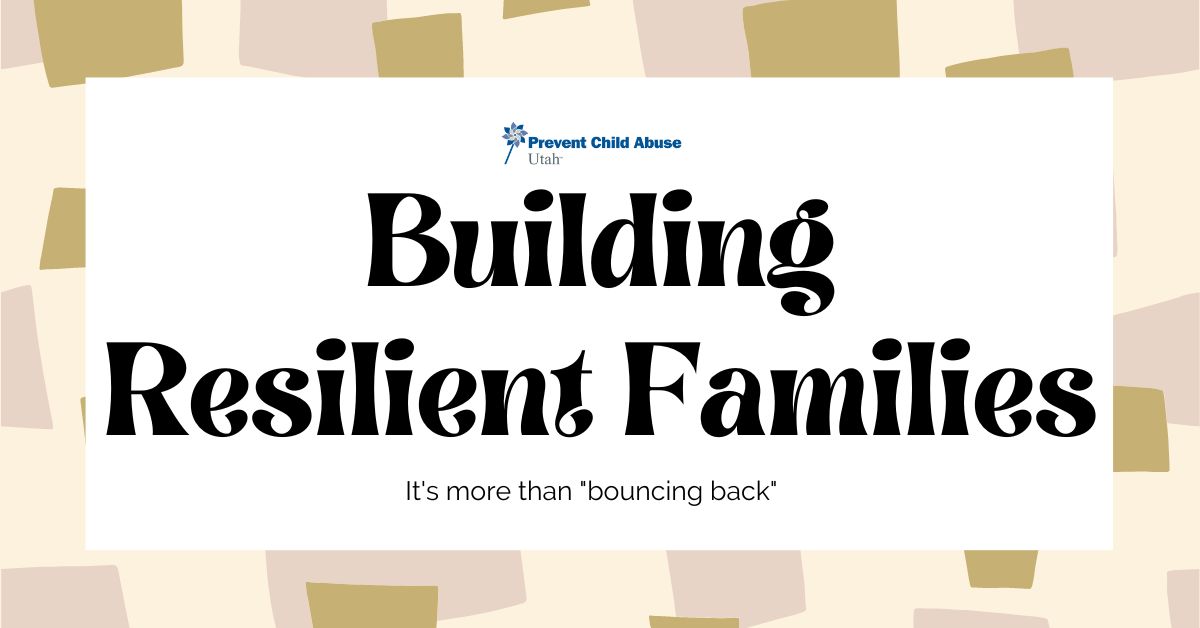
Teaching children and adults how to recognize, resist, and report child abuse is an important part of keeping kids safe. But reporting abuse is only part of the solution. It’s just as important to help families and communities build protective factors. Protective factors prevent abuse from happening in the first place! You can start building resilient families by following the steps below!
What is Resilience?
Resilience is often defined as “bouncing back”, but it’s much more than that. According to the American Psychological Association, resilience is the ability to adapt to or cope with adversity (including trauma, tragedy, threats, and significant stress) in a positive way. Resilience involves behaviors, thoughts, and actions that can be learned over time and nurtured through positive relationships with parents, caregivers, and other adults. Even if abuse has already happened, resilience helps survivors thrive despite their experiences.
Previous thinking on happiness went as follows: happiness is the reward we get for being successful. In truth, the opposite is true. “New research in psychology and neuroscience shows that it works the other way around: We become more successful when we are happier and more positive” (Shawn Achor, The Happiness Advantage). We should remember that our personal definition of “success” plays a major role in how we view ourselves and others. It can be helpful to reframe and rethink our priorities and definitions of success so we can set reasonable goals that focus on what matters most to us.

Building Positivity
The human brain is wired to find the negative in its environment; it’s what keeps us safe. Unfortunately, this means we’re prone to panic or stress unnecessarily. One way to offset this tendency is to purposefully practice positivity. The following steps can increase our ability to find the positive:
- List 3 things in your life that you’re grateful for! This trains the brain to look for positives. The more we practice gratitude, the better we get at reaping its rewards.
- List 3 good things that went WELL during your day and why those things happened. This allows your brain to relive and remember them.
- Journal about 1 positive experience in the last 24 hours. This lowers levels of worry and pessimism and allows you to think deeply about the circumstance.
- Consciously smile 3 times. This releases dopamine and improves mood. Smiling is also contagious!
- Move your body. Physical activity teaches your brain that behavior matters. Research suggests that exercise can decrease anxiety by 20%.
- Practice meditation or mindfulness. These practices allow your brain to slow down, focus on the task at hand, and fall in love with ordinary circumstances of life.
- Practice Random Acts of Kindness. Doing good leads to feeling good! Acts of kindness add meaning to our lives which can act as the most powerful buffer against adversity. Kindness leads to a positive ripple effect which can be far reaching.
Resilience isn’t ONLY about positive thinking. While promoting a positive mindset can be helpful, it can lead to “toxic positivity”. Toxic positivity dismisses very real obstacles people face such as poverty or backgrounds of oppression. Resilience is more than telling people to “pull themselves up by their bootstraps”. Rather, it’s helping individuals to brainstorm realistic solutions to the obstacles they face. These solutions could be accessing community support, tackling problems one step at a time, and moving forward despite the injustices they suffer. Promoting resilience isn’t just the responsibility of the individual but the community as well.
Recognizing Strength
When building resilience, we should remember the value of a Strengths-Based approach. This type of approach focuses on what we CAN do, rather than focusing on what we CAN’T. It helps us to build from where we are. The strength-based approach allows people to see themselves at their best and recognize their own value. This helps us move forward by using our strengths instead of getting discouraged by the negative. When analyzing a problem, ask yourself the following strength-based questions:
- What is working well?
- What am I doing that is causing those things to work well?
- What small things can I do today that would make a positive difference?
- What do I believe my talents or skills are?
- What would others say my talents or skills are?
- What are 3 things that have helped me to overcome obstacles in the past?
- How have people around me helped me overcome challenges?
- What is most important in my life?
- Who is most important in my life?
- What resources such as community, people, aids, and equipment do I have access to?
Life is difficult, and learning to build resilience is a lifelong project. No family can completely avoid challenges. But even though challenges and set backs can be difficult, they don’t have to define us. By practicing gratitude and training our brains to recognize what’s working, we can learn from our mistakes. Doing this will help us persevere through adversity and grow stronger than we were before.
If you would like to learn more about building resilience, check out our home visitation programs.
